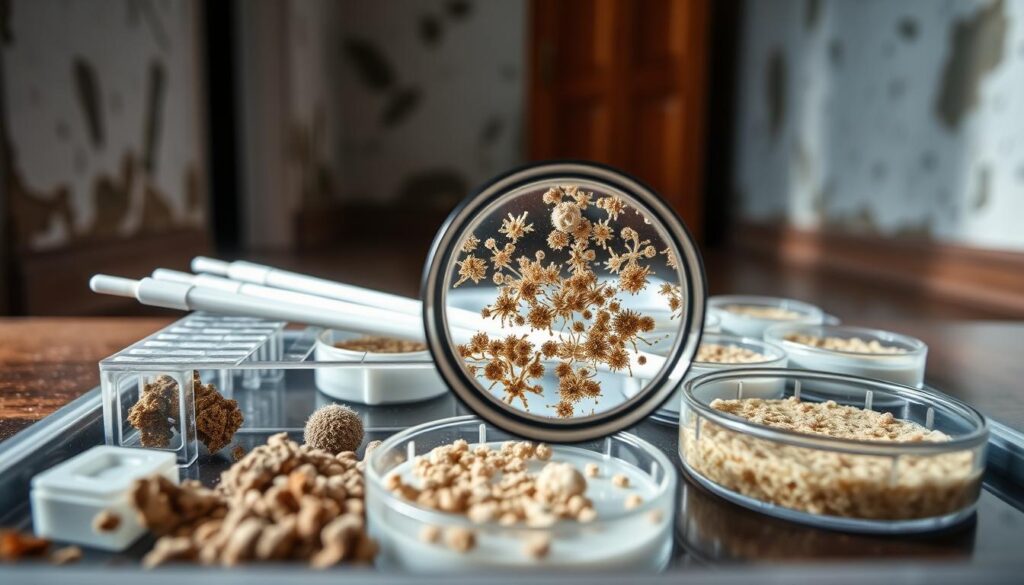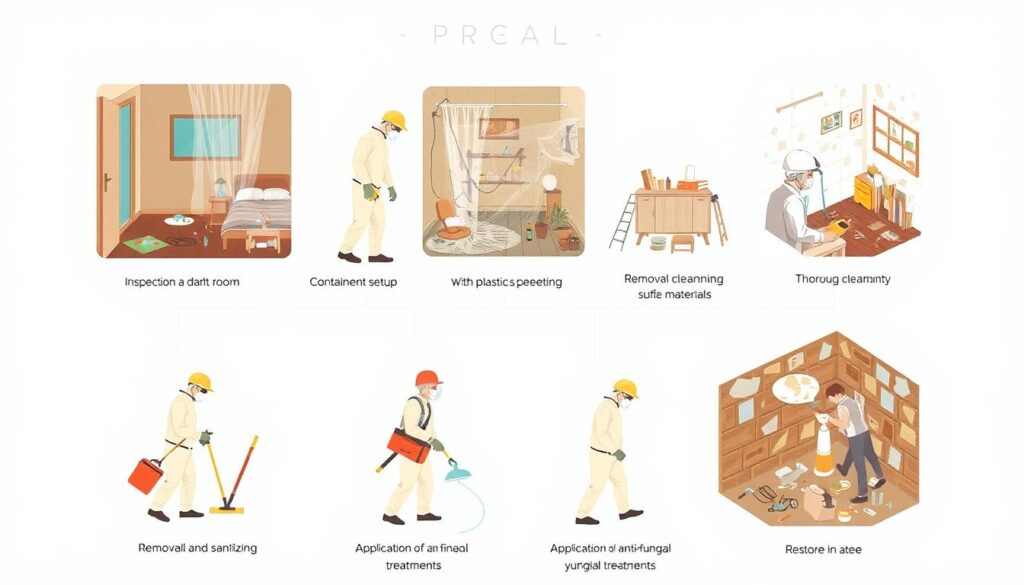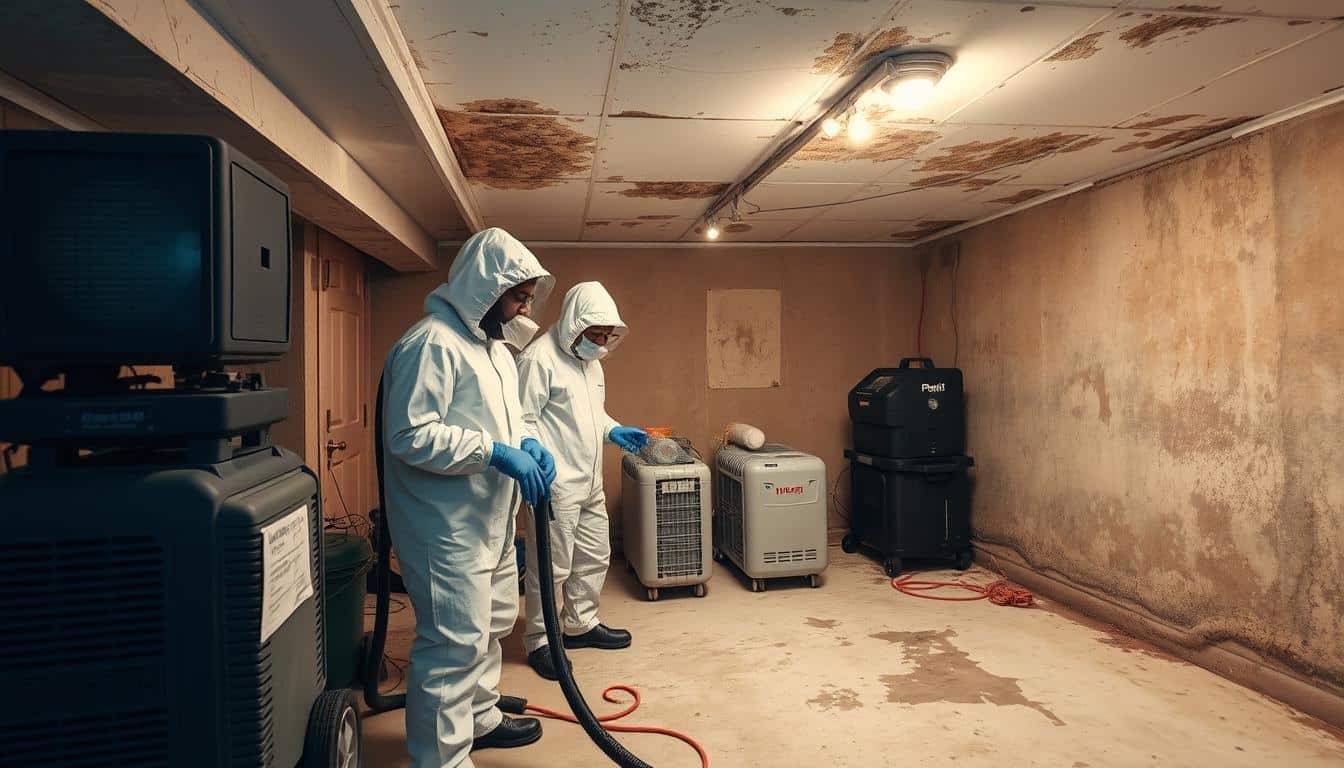Did you know mold remediation is a detailed and expensive task? Mold experts wear protective gear for every job, from toxic black mold to non-toxic types. They do more than just remove mold. They treat the root cause, prevent future growth, and safely dispose of harmful substances.
Key Takeaways
- Mold remediation companies use EPA-approved biocides to kill mold and encapsulants to prevent future growth.
- Mold remediation crews clean the air using HEPA air scrubbers and dispose of moldy building materials.
- Post-remediation inspections ensure proper treatment and identify the need for humidity control measures.
- Mold remediation requires specialized personal protective equipment (PPE) to protect workers’ health.
- Mold can pose serious health risks, especially for vulnerable populations like the very young and old.
Understanding Mold Remediation Beyond Removal
Mold remediation is more than just removing visible mold. It’s about fixing the real problem that caused the mold. Mold remediation services take a detailed approach to solve the issue at its root.
Remediation Versus Removal
Mold remediation is different from just removing mold. It involves checking the area, finding out the mold type, and creating a specific plan. This method not only removes mold but also fixes the moisture problems that caused it. This way, it keeps the air inside clean and safe.
The Mold Remediation Process
- Comprehensive inspection and testing to identify the type and extent of mold growth
- Containment of the affected area to prevent the spread of mold spores
- Removal of contaminated materials using specialized equipment like HEPA vacuums
- Disinfection and treatment of surfaces with EPA-approved antimicrobial agents
- Addressing and repairing the underlying moisture issues to eliminate the source of mold
- Final cleaning and air quality testing to ensure the space is safe and mold-free
Professional services do more than just remove mold. They also stop mold from coming back. This keeps everyone healthy and the building safe.
Comprehensive Testing and Identification
Identifying the types of mold in a property is key. With over 5 million fungi species worldwide, a good mold remediation company will test thoroughly. They aim to find out which mold types are growing.
The mold remediation process includes several tests:
- Moisture testing to find where mold grows.
- Air sampling to check mold spore levels and types.
- Multi-location testing for various factors like TVOC’s, PM2.5, PM10, RH, CO2, CH20, and temperature.
Experts collect samples from both affected and unaffected areas. This detailed analysis helps them create a specific plan to tackle the mold problem.
Mold spores spread fast in damp places. So, professionals use barriers and negative air pressure to keep mold contained. They might throw away moldy items like carpets and drywall in a regular landfill, following local rules.

Removing visible mold is just part of the job. Experts also use strong antimicrobial sprays on porous items that can’t be thrown away. The cleaning stage might involve wet wiping, sanding, or abrasive blasting, depending on the contamination level.
A successful mold remediation needs a detailed plan. This includes testing, containment, cleaning, and a final check. This thorough process makes the property safe and free from mold.
Air Quality Testing: A Crucial Step
Air quality testing is key in mold remediation. It checks if mold has been fully removed. It also tells clients what kind of mold was there and if it’s safe.
Using a third-party for this test is important. It shows you’re fair and trustworthy. This helps build trust with your clients.
There are different ways to test the air. Viable and non-viable air sampling are two common methods. Viable sampling gives detailed info on air microorganisms. Non-viable sampling is faster and cheaper, but it only shows the genus, not the exact species.
The goal of air quality testing is to find any leftover mold spores. It makes sure the air inside is safe again. This is especially important because some companies might miss spores in air ducts after cleaning.
Mold in the home can exacerbate allergies and asthma, and some species can cause mold toxicity.”
Working with a trusted third-party for air quality testing shows you care. It proves you’re dedicated to thorough and effective mold remediation air testing services.
Hazardous Waste Removal and Environmental Compliance
Mold remediation is more than just removing visible mold. It also includes safely disposing of hazardous waste. This waste can be chemicals, contaminated materials, and toxic substances. They must be disposed of according to strict environmental laws.
Reasons to Partner with Hazardous Waste Companies
Proper hazardous waste removal is key to protect the environment and follow laws. Working with a licensed hazardous waste company offers many benefits:
- They know how to handle and move hazardous materials safely.
- They make sure all environmental regulations for mold remediation waste disposal are followed.
- They provide the right paperwork for tracking waste.
- They have access to approved places for safe disposal or storage.
- This reduces the risk for the mold remediation company.
By teaming up with a trusted licensed hazardous waste company, mold remediation experts can focus on their main tasks. They ensure hazardous waste is disposed of safely and legally. This partnership protects the environment and the reputation of the remediation business.
| Key Statistic | Metric |
|---|---|
| Percentage of Projects Requiring Soil & Groundwater Remediation | XX% |
| Percent Increase in Contaminated Soil Removal & Disposal | XX% |
| Number of Businesses Needing Universal Waste Removal | XX |
| Regulatory Compliance Rate for Waste Profile and Manifest | XX% |
| Percentage of PCB Removal Projects | XX% |
| Frequency of Underground Storage Tank Removal | XX |
| Annual Number of Train Derailment Emergency Response Services | XX |
| Number of Facilities Requiring Decontamination Services | XX |
“Proper hazardous waste disposal is legally mandated to prevent environmental harm. Improper disposal of hazardous waste by a remediation company can result in severe fines and penalties.”
Preparing for Mold Remediation: What Homeowners Should Do
Before the mold remediation crew comes, there are steps you can take. These steps help make the process smoother and more efficient. As a homeowner, your role is key to the project’s success.
Steps Before the Remediation Crew Arrives
- Fix the water problem that caused the mold. This is crucial to stop mold from growing again.
- Clear a path for the crew to move easily. This lets them work well and disturb your home less.
- Keep pets out of the way. Mold remediation can be messy, so keep your pets safe.
When the crew arrives, they will start by containing the mold area. They will park their truck close, lay down plastic, and set up hoses. This is to safely remove the mold.
By preparing in these ways, you help ensure a successful mold remediation process. This makes your home healthier and safer.
“Addressing the moisture issue that caused the mold is crucial to preventing future growth and creating a healthy home environment.”
The Mold Remediation Crew’s Procedures
When dealing with mold in homes or businesses, the mold remediation process is key. Professionals at companies like Compleat Restorations use a detailed approach. This ensures mold is removed and won’t come back.
The crew starts by wearing full protective gear. They use head-to-toe white suits, booties, respirators, and goggles. This keeps them safe and stops mold spores from spreading.
Next, they spray the moldy area with a strong EPA-approved biocide. This solution kills mold. They let it work overnight.
The next day, they cover the area with plastic sheeting. This isolates the moldy zone. Then, they spray the moldy surfaces with an encapsulant. This special coating traps mold spores and stops them from growing.
- They use HEPA air scrubbers to clean the air and change it out. This removes mold particles from the air.
- HEPA vacuums are used to clean floors and surfaces. They make sure no mold spores are left behind.
This careful mold remediation process makes sure the property is mold-free. It also removes hidden mold that could cause problems later. By following these mold remediation steps and using the latest mold remediation techniques, the crew can make the affected areas safe and healthy again.
| Mold Remediation Procedure | Purpose |
|---|---|
| Containment and Isolation | Prevent the spread of mold spores to unaffected areas |
| Biocide Application | Kill and eliminate active mold growth |
| Encapsulation | Trap and lock in any remaining mold spores |
| HEPA Air Scrubbing and Vacuuming | Remove airborne mold particles and thoroughly clean surfaces |

Working with experienced mold remediation companies like Mold Remediators USA ensures your property is safe. They fix the mold problem at its root. This prevents it from coming back.
What Do Mold Remediation Companies Do?
Mold remediation companies are key in tackling mold problems in homes and businesses. They don’t just remove visible mold. Their aim is to find and fix the root cause, stop mold from coming back, and make sure the place is safe and healthy.
These companies use a detailed process. It includes testing, air quality checks, removing hazardous waste, and following strict environmental rules. This way, they can safely remove mold risks and offer a lasting fix.
Mold Remediation Process
Mold remediation companies have a clear plan to tackle mold. Here are the main steps:
- They start with thorough testing to find out what kind of mold and how bad it is.
- Next, they check the air quality inside to see how it’s affected.
- Then, they carefully seal off the moldy areas to stop mold spores from spreading.
- They remove and dispose of moldy materials safely, following strict rules.
- After that, they clean, disinfect, and cover the affected areas.
- They also fix the moisture problem to stop mold from coming back.
- Finally, they do a final test to make sure the place is mold-free and safe.
Working with a professional mold remediation company ensures mold problems are solved right. It keeps the property safe and healthy for everyone living or working there.
| Mold Remediation Timeline | Typical Duration |
|---|---|
| Mold Remediation Process | 1 to 5 days |
| Factors Impacting Duration | Severity of mold, duration of presence, type of contaminated material, location |
Knowing what mold remediation companies do helps homeowners and businesses tackle mold problems well. For more info, check out this guide on mold testing and.
Understanding Mold Types and Costs
There are many types of indoor mold that can harm your home. These include Aspergillus, Alternaria, Cladosporium, Chaetomium, Penicillium, and Stachybotrys, or black mold. Knowing about these types is key to fixing the problem right.
The cost to fix mold can change a lot. Labor costs are about $99 an hour. For big mold problems, costs can go up. Mold checks cost between $300 and $1,000.
The fix process takes one to five days. It includes repairs, cleaning, and drying. Even though getting rid of all mold spores is hard, pros can keep it under control.
| Mold Type | Average Cost to Remove |
|---|---|
| Aspergillus | $1,000 – $3,000 |
| Alternaria | $1,000 – $3,000 |
| Cladosporium | $1,000 – $3,000 |
| Chaetomium | $1,500 – $4,000 |
| Penicillium | $1,000 – $3,000 |
| Stachybotrys (Black Mold) | $2,000 – $8,000 |
Trying to fix mold yourself might save money at first. But, it can lead to more problems. Experts have the right tools and knowledge to fix it safely and right.
Even though hiring pros costs more upfront, it’s worth it. The cost is usually between $1,128 and $3,450. This is because fixing it right now saves you from bigger problems later.
Mold Testing: When and How
Mold testing is key when dealing with mold concerns. Visible mold growth means action is needed. Testing helps understand the problem’s extent and severity. It’s important for suspected mold issues or to check air quality.
Visible mold means it’s present and needs action. But, if you’re unsure or want to know the mold types, mold testing is helpful.
DIY mold test kits are available for $10 to $15. They include a swab, petri dish, gloves, mask, and mailer. These kits help detect mold spores in air or on surfaces. After sending the sample, you get results in a few days.
For a detailed approach, professional mold testing is better. It includes a thorough inspection and sampling. This gives insights into the mold’s causes and how to fix it.
“Proper mold testing aims to determine the presence of mold, locate its sources, assess the extent of the problem, and suggest corrective actions.”
Mold testing is crucial for big mold problems or when the source is unclear. Knowing the mold types and levels helps create a focused remediation plan.
Whether using a DIY kit or professional services, act fast on mold concerns. Identifying and addressing mold ensures a healthier home for you and your family.
The Complete Mold Remediation Process
Fixing a mold problem in your home or business needs a detailed mold remediation process. This process removes mold completely and stops it from coming back. It keeps everyone safe and healthy. Let’s look at the main steps of the mold remediation process.
Containment and Ventilation
The first step is to set up mold containment and ventilation. A barrier is made around the moldy area to stop spores from spreading. Air filters and negative air pressure systems catch and remove mold particles in the air.
This makes sure the cleanup team and everyone else stay safe.
Cleaning, Disinfecting, and Encapsulation
After the area is sealed off, the next step is cleaning, disinfecting, and encapsulating the moldy surfaces. Moldy materials are removed, and EPA-registered fungicides are used to kill spores. Then, a protective coating is applied to stop mold from coming back.
The mold remediation process tackles the mold and the reasons it grew. By following these steps, mold can be removed, and it’s less likely to come back. This makes your indoor space healthier and safer for everyone.
“Proper mold remediation is essential for protecting the health and safety of building occupants.”
Conclusion
Mold remediation is key to keeping homes and businesses safe. It involves a detailed process to get rid of mold and stop it from coming back. This makes sure the place is healthy and safe.
Knowing the steps in mold remediation is important. It starts with testing and finding the mold, then removing hazardous waste and sealing it up. Quick action is crucial to avoid health problems and protect your property.
Getting help from mold specialists is a smart move. They are experts who know how to handle mold problems. They make sure your place is mold-free, giving you peace of mind for a long time.
FAQ
What do mold remediation companies do?
Mold remediation companies tackle mold problems in homes and businesses. They use a detailed process to remove mold and prevent future growth. This ensures the property is safe and healthy.
What is the difference between mold remediation and mold removal?
Mold remediation and removal differ. Removal only fixes the surface, not the root cause. Remediation companies test, inspect, and treat the mold. They also prevent future growth.
How do mold remediation companies test for and identify mold?
Companies test to find mold types. They also check for hidden mold growth. This helps prevent future problems.
Why is air quality testing important in the mold remediation process?
Air quality tests confirm mold removal success. They show mold type and remaining amounts. This builds client trust.
What is the process for safely removing hazardous waste during mold remediation?
After testing, toxic substances are safely removed. This follows environmental laws. It reassures clients about safety.
What should homeowners do to prepare for mold remediation?
Homeowners should fix water issues and clear paths. They should also keep pets away.
What are the steps the mold remediation crew takes on-site?
Crews wear protective suits and spray mold areas. They return to apply encapsulant and clean the air. This removes spores.
What are some common types of indoor mold?
Common indoor molds include Aspergillus, Alternaria, and Cladosporium. Stachybotrys, or black mold, is also common.
How much does mold remediation typically cost?
Costs vary by location, mold type, and needed repairs. It depends on the situation.
When should I test for mold, and how do I do it?
Test if mold is visible or suspected. DIY kits cost to . They detect spores and provide results in days.
What are the key steps in the mold remediation process?
Steps include containment, cleaning, and addressing moisture. Ventilation and air filtration are crucial. Cleaning and disinfecting remove infected materials. Encapsulation deals with remaining mold.




